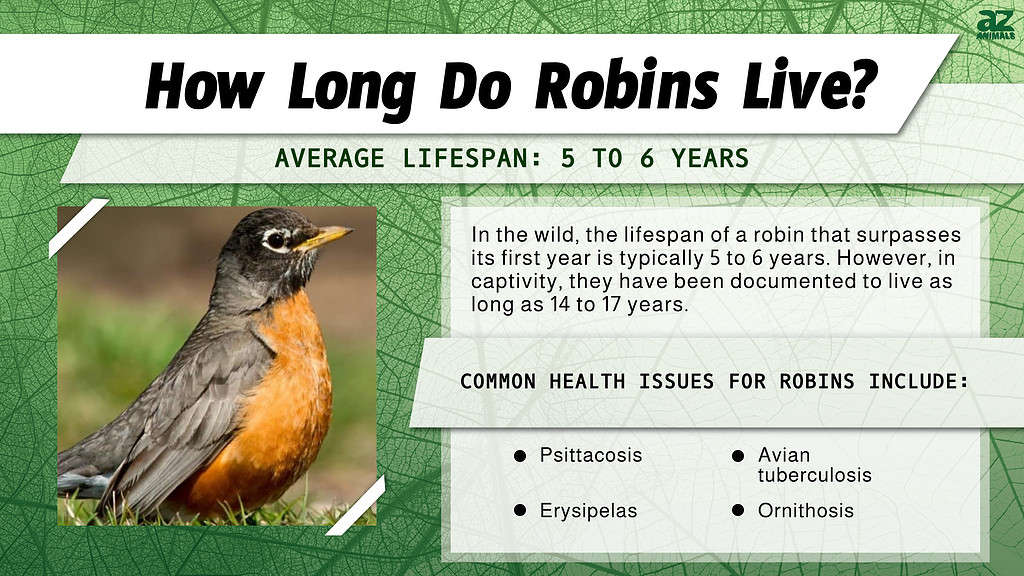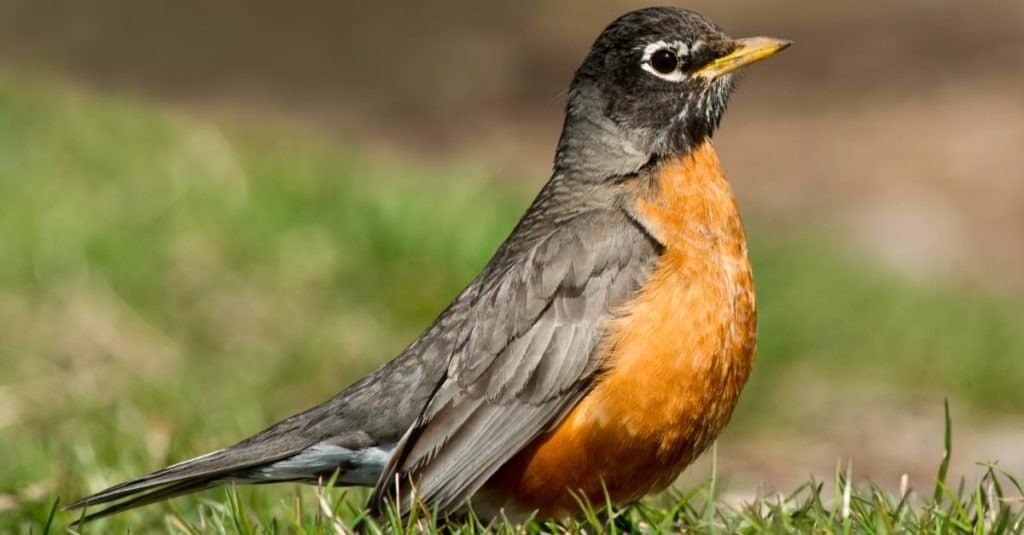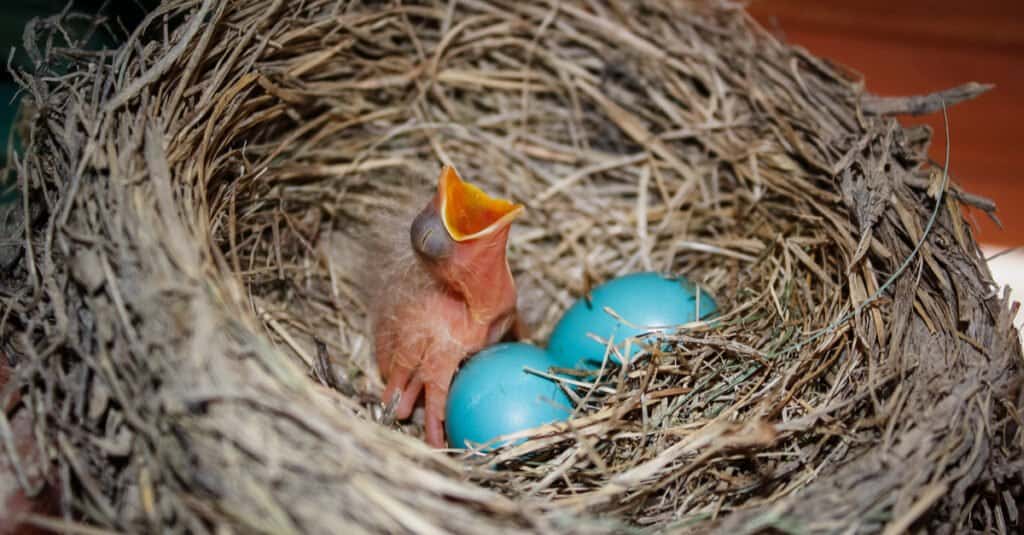
The robin is one of the most recognizable birds in the United States. You almost certainly have seen a robin in your yard, no matter where you live in America.
The songbird is ubiquitous across the country. There is also the European robin, another incredibly recognizable garden bird found throughout Europe. However, throughout this article, we’ll focus on the American robin.
Aside from their beautiful exteriors, robins are also known for being associated with the start of spring. Seeing a robin is usually a good indication that spring is coming.
Whether you happen to love learning about robins or birds in general, we’ve got all the information for you. We’ll uncover what the average robin lifespan is in the wild and what factors impact how long they live.
What is the Average Robin Lifespan?

In the wild, a robin can live for 5 to 6 years.
©Paul Reeves Photography/Shutterstock.com
The lifespan of a robin who lives past its first year is 5-6 years in the wild. However, in captivity, they have been recorded to live for as long as 14-17 years old.
The life expectancy of a robin greatly increases if it survives to at least a year old. This is because robin offspring are often quite susceptible to environmental stressors. In fact, only around a quarter of baby robins survive their first year. However, once they surpass the first year, a robin would have acquired many important life skills that would help them to survive.
According to “Life History,” The American Robin, the oldest recorded robins were both 17 years old. There was a captive robin at Tarrytown, N.Y., that lived for 17 years and another robin at Richmond, Oregon, that was reported to be alive and healthy at 17 years old.
The robin’s lifespan is incredibly fragile during the first year, and it is this time that determines how long they will actually survive. Curious about how a robin goes from an egg to an adult songbird? Let’s find out!
The Average Robin Life Cycle
The robin life cycle is quite similar to many other bird species. Find out what the common life cycle stages are and how you might better sight a baby robin.
Mating
At one year old, robins are already considered adults and are able to reproduce. Mating occurs mainly from late March to June. Robins have a courting ritual in which the male sings to and then feeds the female. Male robins will sing to announce that they are looking for a mate. Once they find a mate, they will sing to assert their territory. This occurs just before the eggs hatch.
Eggs
The female will begin to construct her nest so that she may begin laying the eggs. During their initial nesting season, most robins will only lay around 3 to 4 eggs. Sometimes just two eggs are laid in the second and third nestings of the season. Robin eggs are instantly recognizable because of their beautiful blue color. After the last egg is laid, incubation lasts 12-14 days.
Hatchlings

Baby robins are called hatchlings!
©Melinda Amburgy/Shutterstock.com
Twelve to fourteen days after the last egg is laid, the first baby hatches. Eggs typically hatch one day apart, in the sequence in which they were laid. These new baby birds are called hatchlings. For the next 13 days, the parents will be the main source of care for the babies. Both parents feed the young and they can have some hearty appetites. During the first four days of a hatchling’s existence, the parent birds regurgitate partially digested food into the mouth of each infant. Every day, the hatchlings consume more. Soon they are fed whole worms and large insects.
Fledgling
When baby robins are around 13 days old, they are ready to leave the nest. This means they have reached the fledgling stage, where they begin to learn to fly. When baby robins leave the nest, they are unable to fly well. To become powerful fliers, they must develop muscles and grow adult feathers. The parents will still continue to feed them for a few days, but once the mom leaves to lay new eggs, they are all on their own.
Adult
To reach adulthood, a robin must reach a full year of life. To accomplish this, they will often fly with a flock of experienced robins. The robin will continue to fly and find new ways to get food. They will then begin to prepare for winter, as many of them migrate to warmer areas during this time.
What Factors Impact the Robin Lifespan
There are many external and environmental factors that will impact a robin’s lifespan. A young American Robin’s chances of survival improve if it survives its first winter. However, even if they do survive, robins do not wind up living very long in general. To learn more about what impacts how long a robin may live, keep reading.
- Predators: robins fall prey to many predators, even when they’re still only in their eggs. There are a large number of predators that will attempt to steal robin eggs from their mother’s nest. These include squirrels, snakes, crows, blue jays, and even raccoons. Once again, robins are susceptible to becoming prey. Hawks, shrikes, and owls all hunt down robins. Cats are also another predator that robins have to watch out for.
- Food Availability: food availability issues can become a serious one for robins. When robins migrate during the winter it’s not usually because they can’t handle the winter. In fact, their feathers can keep them quite warm during the cold, harsh weather. The true incentive is food, or rather the lack thereof. As their diet of earthworms and insects dwindles because of the weather, robins start looking for new food. American Robins continue to be poisoned by pesticides because they graze on lawns and other open areas frequently treated with chemicals.
- Collisions: every year, a few migratory robins are killed by communications towers. Other typical risks for a robin include collisions with glass, electrocution, and automobile strikes.
The photo featured at the top of this post is © iStock.com/Silfox
Thank you for reading! Have some feedback for us? Contact the AZ Animals editorial team.






